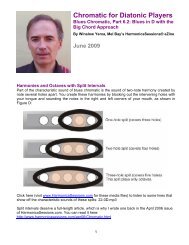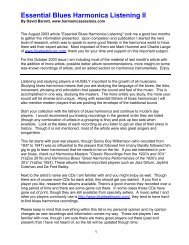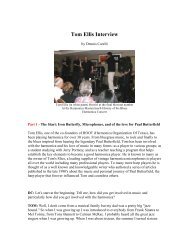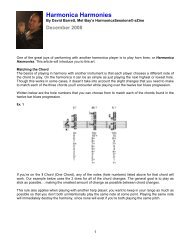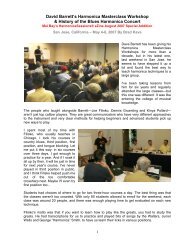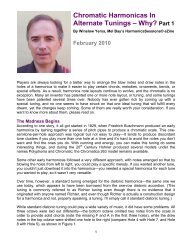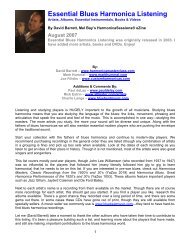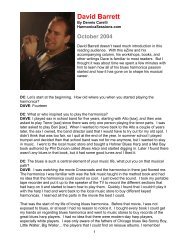Tom Ellis Interview - Mel Bay's Harmonica Sessions
Tom Ellis Interview - Mel Bay's Harmonica Sessions
Tom Ellis Interview - Mel Bay's Harmonica Sessions
You also want an ePaper? Increase the reach of your titles
YUMPU automatically turns print PDFs into web optimized ePapers that Google loves.
<strong>Tom</strong> <strong>Ellis</strong> <strong>Interview</strong><br />
By Dennis Carelli<br />
<strong>Mel</strong> Bay’s <strong>Harmonica</strong><strong>Sessions</strong>® eZine<br />
August 2005<br />
<strong>Tom</strong> <strong>Ellis</strong> (in white pants) blowin’ at the final blowout number<br />
At the <strong>Harmonica</strong> Masterclass® History of the Blues<br />
<strong>Harmonica</strong> Concert<br />
Part 2 of our interview with <strong>Tom</strong> <strong>Ellis</strong>, one of the co-founders of HOOT (<strong>Harmonica</strong><br />
Organization Of Texas), owner of <strong>Tom</strong>'s Mics, a leading supplier of vintage harmonica<br />
microphones to players all over the world, an excellent harp player for over the past 30<br />
years and the author of a series of articles on the music and personal journey of Paul<br />
Butterfield.<br />
DC: Did Paul Butterfield ever use a bullet-style mic?<br />
TOM: Well, I don’t think on a regular basis. I have a picture on my wall of Butterfield and<br />
Jr. Wells on stage at Big John’s and Butterfield is playing through a JT-30. But I don’t think<br />
that was his choice. I think the first mic he used on the Lost Electra <strong>Sessions</strong> album and<br />
prior to that I think he probably used a JT-30 for a bit but he transferred pretty quickly over<br />
to an Altec mic which was actually an Electro-Voice crystal mic. But it looked a whole lot<br />
like a Shure 545. It had an on-off switch which is something he felt he really needed.<br />
Don’t forget back in those days, there were no bullet mics with on-off switches or volume<br />
controls. No one was making a harp mic. Then I think in late ‘64 or early ’65 he changed<br />
over to a Shure 635 which was a long wand style mic. It looked a whole lot like a Shure<br />
SM57. He changed over because [Little] Walter was playing one. Then in ’65, certainly by<br />
late ’65 Shure had started to release the 545 in Chicago. And there is that famous picture<br />
of Walter holding one of those. When that happened everybody went to it [545]. I know<br />
Billy Boy [Arnold] was playing one. Everybody who was anybody in Chicago, just about,<br />
with the exception of [James] Cotton went to a 545. Not long after that, Fender sponsored<br />
1
The Butterfield Blues Band, Electric Flag and The James Cotton Band. Included in that<br />
sponsorship were not only the amplifiers and the PA system but also this full array of<br />
Shure microphones. This was the time that Cotton went to the 533 with the volume control.<br />
So everybody got Shure mics. I’ve actually seen and I got to rummage thru Butterfield’s<br />
kit. His ex-wife let me look at it a couple of years ago when I was out in California. He still<br />
had his 3-pin 54PE still in his kit. The microphone he had probably since 1966 or 1967.<br />
DC: Refurbishing and customizing vintage microphones is still one of your passions?<br />
TOM: We do as much of it as we can. We do a lot of custom work where we put in on-off<br />
switches and volume controls. We mix and match mics and elements. Today I sent off a<br />
coupe of JT-30’s to guys who wanted controlled magnetic elements or controlled<br />
reluctance elements. The problem with working with anything vintage including<br />
microphones is that the availability of parts just isn’t there. The United States government<br />
only requires a manufacturer retain parts for products made ten years from the date of<br />
their manufacture. So when you get a microphone made in 1965 it’s pretty hard to find<br />
parts. During the time in the microphone business over the last years, [I] don’t even know<br />
how long it’s been now, we bought up just hordes and hordes of vintage part stocks. From<br />
Shure and from Electro-Voice from everybody else. And of course all that stuff has been<br />
used up. We still try to do the best we can now. There are a lot of little tricks and little<br />
things people can do with their own equipment to fix it up in case it’s not working. We try<br />
and pass that information along too.<br />
DC: Moving from mics, not that mics aren’t a topic you are passionate about, to some<br />
other areas. Clearly the next topic is one you are very passionate about. All this time you<br />
are playing and your interest is heightened if not accelerated when you first heard about<br />
and then heard Paul Butterfield. When did you go into it deep, deep, deep in terms of<br />
researching, investigating and writing about him? Was that a gradual thing over some time<br />
or was there a specific event that launched you into his history and music?<br />
TOM: When I first started listening to Butterfield I kind of made this habit of anytime I saw<br />
anything about his record or his stuff, I would always cut them out and cram them into the<br />
sleeve with the record. So I had gathered that stuff up and of course any time that I could<br />
read about him, I read about him. When the blues thing went dead, probably went dead in<br />
the 1980 or 1979. I mean it really was dead. It was real hard to find out anything about any<br />
of these guys. I got to see Butter here in Dallas probably on one of the last tours, probably<br />
was the last tour he made through this area. A night of alternating extreme elation and<br />
extreme sadness cause he started off so great and then got himself so messed up at one<br />
of the breaks and came back. Man it was almost pathetic. I got to see him and I got to see<br />
Jerry Portnoy. A lot of these guys came through town playing these little tiny places. When<br />
Butterfield died, I remember exactly where was I. I was driving and I remember hearing it<br />
on the radio and being kind of shocked. I had just gotten a cell phone in my car and I<br />
picked up the cell phone and called a friend of mine. I said you are not going to believe<br />
that Butterfield just died, it kind of re-emphasized how important he was to me. There was<br />
a real interesting editorial in, believe it or not, Esquire about him and how important he had<br />
been to some of the guys who owned and who were writing for Esquire at the time. That<br />
made me think that nobody really knew what he had done and I knew how important he<br />
had been to me.<br />
I started doing some writing for a blues magazine called Blues Access. I just queried them<br />
one day. I thought nobody had ever written this story before. I was hearing people really<br />
running Butterfield down. I talked to people through the mic business almost every day and<br />
2
if I ever mentioned Butterfield it was like, ‘Oh, he didn’t tongue block. He didn’t do this.<br />
Didn’t do that.’ Always ragging on Butterfield. I just thought these people just don’t get it.<br />
They don’t understand it. Now and then I would meet someone like Rob Paparazzi or<br />
somebody… or even Howard Levy who would go on and on about him. So I just queried<br />
the magazine and said I would make these guys a deal. If you’ll pay for my research costs<br />
I’ll do the article. I did one article. I had so much information in the first article it was like I<br />
need to do another one. And that started the series that ran in Blues Access that ran over,<br />
gosh, almost three years. Five parts. It was almost a novella length. I think it was about<br />
35,000 words before we were finished with it. That just really got me going. I got to meet<br />
all the guys that had always been the guys on the album covers that I held and looked at<br />
as I sat and listened to the music. I got to meet all of them, well not all of them. Some of<br />
them were dead and some unfindable. That’s what started it.<br />
DC: Given the background and that research, how would you describe his impact on the<br />
blues music scene?<br />
TOM: A couple of weeks ago, [Joe] Filisko and I had a long talk about his on the way to<br />
the <strong>Harmonica</strong> Masterclass in Austin. I think that the problem, well it’s not a problem. Let<br />
me tell you what I think that most harp players today do. They have a very stilted<br />
perception on the harp player as musician. They see the harp player as somebody who if<br />
he does not mimic or have great devotion to and play somewhat like, and that’s the key<br />
phrase, the greats – the Walters, George Smith and all the guys you talk about in your<br />
[Masterclass] classes, that if a harp player doesn’t show some direct allegiance to them in<br />
his playing style they tend to downplay them a lot. They also don’t understand, or I think<br />
they overlook because I don’t think they don’t understand it, the fact that in the era when<br />
those guys came up there were two kinds of harp players. There were harp player leaders<br />
and there were harp player sidemen. And the harp player sidemen were the great people<br />
like Walter Horton and primarily people like George Smith. Well I can’t say George Smith<br />
cause he was more of a leader. [James] Cotton was certainly someone I would put into<br />
that sideman category much more so. [Little] Walter is somebody I would put into the<br />
leader category. Jr. Wells into the leader category. Butterfield into the leader category.<br />
And these were guys that had a very distinct attitude about not only the music they were<br />
playing, but the style in which they played it.<br />
Butterfield saw no reason to be beholding to the Walters or Cottons or Wells’ of the world.<br />
In fact when he was growing up and when he got up on the bandstand and sat in with<br />
Muddy [Waters] and sounded like Little Walter that didn’t get him any accolades from the<br />
audience. He didn’t like that. He wanted to hear something new and unique and different.<br />
And it was his immediate acceptance by these black audiences and by the Muddys and all<br />
the other people he played with back when he was growing up that led him to immediately<br />
get the stamp of approval on the way he approached the instrument. So why did he need<br />
to sound like anybody else? His own sound was his own sound. He went with it and went<br />
with it. And I think a lot of guys today think that if you get up on stage and if you don’t<br />
sound like Big Walter or Little Walter, you are not gong to be accepted by the basic group<br />
of harmonica players that are out there. I think unfortunately that in many cases, that’s the<br />
truth. But the guys who appreciate somebody who has a very unique sound, they tend to<br />
be around a little longer and go a little further.<br />
Charlie Musselwhite is a great example of a guy who not only has his own sound but<br />
Charlie is just fearless. He is unafraid of 4 th position or 5 th position or Cuban music or you<br />
name it. He is a guy who has his own distinct attitude about what his music should be and<br />
3
Butterfield did too. I think people also over look the fact that when Butterfield was coming<br />
up in order to be a leader you had to be a good singer. You had to have that emphasis on<br />
singing. And there are not many harp players out there today who have the combination of<br />
great harp style and great vocal style that you saw from the Butterfields, maybe the<br />
George Smiths. I don’t know his singing style and if I would put it up there near the top.<br />
Certainly Little Walter is an example of that. Cotton I don’t think is [near the top]. I don’t<br />
think Cotton was ever a great singer. I think that what Butterfield was about was not what<br />
harp players see as being important today. Which I think is unfortunate because I think<br />
they overlook a lot. I mean you can listen to Butterfield’s acoustic playing, his 3 rd position<br />
playing and all this stuff. He was fabulous player. Just because he didn’t want to sound<br />
like Little Walter doesn’t mean he wasn’t a great player.<br />
Let me add one other thing about that too, the way the harmonica was integrated into the<br />
band. Butterfield, at least thru the Better Days era and really all the bands he ever had,<br />
always had top flight guys playing with him. He was never somebody who made his band<br />
all about the harmonica. He made his band all about the music. You hear that from the<br />
very first note of Born in Chicago and you hear Elvin [Bishop] playing that slashing slide<br />
guitar, excuse me [Mike] Bloomfield playing the slashing slide guitar in there. It was<br />
always about the ensemble sound and putting across the ensemble sound. Which not<br />
ironically was what Muddy [Waters] was always all about. And what Howlin’ Wolf was<br />
always all about. It was what Chicago blues was all about in the 1950s. And I think today<br />
everybody seems to think that every Chicago blues band was really all about the<br />
harmonica primarily because Muddy had that great line that ‘the harmonica is the soul of<br />
the band.’ The soul is only one piece of the body. There are a whole lot of other parts of<br />
the body. I think of Butterfield because he was not so harmonica-centric in his band<br />
people don’t tend to listen to the whole music. If they listen to the music, they see what<br />
incredible music was coming out of this incredible ensemble of musicians. The harmonica<br />
being just one part. Obviously the part that you and I love the most, but still just one part.<br />
DC: It’s interesting that just the other day I was digging back into some Butterfield albums<br />
for some general listening and in preparation for this conversation and was playing East<br />
West. East West the album but particularly East West the song. And that song is so much<br />
guitar. It’s like 90% guitar. Obviously when Butterfield plays in there he makes an impact<br />
but people so much associate that [song] with him and yet there are two killer guitar<br />
players in there that are just ripping and creating a whole atmosphere for the song.<br />
TOM: It’s funny because if you talk to a guitar player about East West he doesn’t<br />
associate it with being a harmonica song at all. I doubt he could even tell you how the<br />
harmonica part starts cause it is so guitar-centric.<br />
DC: Do you perceive certain phases in his musical career?<br />
TOM: I think the first version of the big band, you know what the Bloomfield band was all<br />
about, was an attempt to really do the Jr. Parker kind of thing. He really wanted to have a<br />
swinging blues band that had a heavy, heavy sound to it when called for. When they did<br />
something like “Double Trouble,” what I would call a stone blues kind of song. But I think<br />
that band morphed into an R ’n B band by the time Keep On Moving came out. Certainly<br />
there was some blues. He did “Walkin’ by Myself” and he did some blues songs. It was<br />
still pretty much of an R ‘n B band. I think by the time the big band ended they were kind<br />
of segueing into kind of a jazzy blues band cause he had some guys who could really<br />
blow. He had a bunch of real heavy jazz cats. Some of whom had played with him of a<br />
long time and he was letting them run. He was letting them run free. That version of “Love<br />
4
March” on the live reissue is one example. I have a lot of tapes where he let Sanborn,<br />
Dinwittie and Steve Madaio blow free. And even Teddy Harris played piano for him. It’s<br />
just pretty heavy duty. What’s interesting to me about Butterfield is that he left that band,<br />
but it was still all about the music. When he did the Better Days thing, he kind of returned<br />
to what I would call his traditional blues roots but he also returned to his very traditional<br />
folk roots.<br />
You know he started out as kind of a street player with a high school friend of his. They<br />
were really into Sonny Terry and Brownie McGee and the whole hootenanny thing. He<br />
was doing that kind of stuff playing a lot of country blues before he met Elvin [Bishop].<br />
Then he met Elvin and they went off more to the Chicago south side. It was still even in<br />
Better Days it was all about the songs. I think in Better Days he thought ‘I kind of<br />
incorporated the blues and the jazz, now I’m going to get a guy from New Orleans and put<br />
him in the mix. And I’m going to get this guy who has impeccable folk credentials, Geoff<br />
Muldaur, and put him in the mix’. Of course he’d known Muldaur for years. So he created<br />
a brand new “stew” of music. After that he never really had his own band last a long, long<br />
time and he found himself in more of a sideman role. I think he did a lot of really, really,<br />
really creative almost unheard of things with the instrument at the time he was playing with<br />
the RCO All-Stars with Levon Helm and some of those bands, some of those Woodstock<br />
oriented bands. He was putting the harp in places you just won’t think it would go in. And<br />
making it really, really work. Then, of course, towards the end of his life he was pretty<br />
much back to playing a lot more traditional blues. I think by that time both his physical and<br />
mental condition were pretty, pretty severe. Things were pretty rough. His drug problem<br />
was rough. I think at that point he was taking a path of least resistance and the path of<br />
least resistance was to slide right back into the stuff he had grown up with in Chicago<br />
when he started playing amplified. Yeah, he did definitely go through phases but I think<br />
what is interesting is that he was able to keep his harmonica a dominant instrument in the<br />
“stew” regardless of what the “stew” was made up of.<br />
DC: He was also the cook of most of that “stew.”<br />
TOM: Well, he was and he wasn’t. A lot of people think Butterfield was this hard-nosed<br />
Howlin’ Wolf kind of leader, but he really did let the other guys go. He pretty much let the<br />
other guys run. And you look at the last couple of big band albums there are as many<br />
tunes contributed by the horn players as there are blues tunes or tunes written by<br />
Butterfield. And certainly the Better Days thing, if you look at those mix of songs you can<br />
see Ronnie Barron credited. You can see [Geoff] Muldaur credited. Or you can see the<br />
direct interjection of things that Muldaur himself wanted to record like the Eric von Schmit<br />
stuff or the Percy Mayfield stuff. Those kind of things. I think Butterfield was a great band<br />
leader. He was like any good corporate executive. You get the best people and then you<br />
kind of let them go.<br />
DC: Yeah, that’s what I really mean. More like the executive chef choosing the<br />
ingredients. Choosing the players to put in there. And then letting the individuals<br />
contribute as each ingredient, letting the players and the band go forward.<br />
TOM: Your right. I think that we don’t see a lot of that today. The Butterfield Blues Band<br />
lasted the better part of five years, six years. It was basically two ensembles in six years.<br />
The first ensemble was wiped away after three years. But the big band ensemble had a<br />
number of key people who stayed with that band pretty much all the way through;<br />
Sanborn, Dinwittie and Butterfield. They were in it pretty much through the whole thing.<br />
And the guys who were new were guys he was meeting when he lived in Woodstock and<br />
5
playing with on a regular basis, every night at jams on Joys Lake and all these clubs up<br />
there. And then there was the Muldaur thing that came back in there. He’d known<br />
Muldaur since the first band, the Bloomfield band. And of course he knew Muldaur’s wife<br />
and they lived up there in Wood stock. They had this tight knit group of people up there<br />
who played with each other in all kinds of weird combinations all the time. So there was<br />
this amazing sense of familiarity. We don’t have much of that today. We don’t have music<br />
towns like Woodstock was or like San Francisco was in the ‘60s. Or Los Angeles was in<br />
the ‘60s. Or Chicago was in the ‘50s. You don’t have these kind of towns where you have<br />
this high number of musicians all of whom are playing with one another and sparking each<br />
other and trying new things all the time and all that. It’s a different time today. I don’t think<br />
people realize how special all that was back then. And Butterfield was trying to keep the<br />
whole thing he grew up with in Chicago together.<br />
DC: I think a lot of people today are dumbed down a little by the commercialism of a lot of<br />
the music.<br />
TOM: Yeah. Well everybody wants to categorize everything. I think what Butterfield was<br />
great about, there’s a line in the liner notes of the Live Reissue that he said something to<br />
the effect that blues comes in a lot of forms. Blues is John Lee Hooker and it’s Nina<br />
Simone and it’s King Pleasure. It’s all these different people. Everything I play has the<br />
blues feeling to it, but it’s not traditional blues. It’s not Chicago blues. It’s the blues. It’s<br />
the blues with a little ‘t,’ not THE blues with a capital “T.” And everybody thinks of the<br />
blues with a capital “T” today.<br />
DC: Yeah, and thinking about what you said earlier about playing in his [Butterfield’s] own<br />
style. To pay something note for note from someone like Little Walter, the audience would<br />
be playing it in their head as he is playing it. So he would not be giving them anything.<br />
TOM: Yeah, exactly. You listen to his playing and you just don’t hear many people play<br />
with that level of intensity. And you don’t hear people play with that level of emotional<br />
connection. There was definitely something there. He had a way of ripping people’s hearts<br />
with his style of harmonica playing. I think he realized that kind of emotional playing that<br />
he was interested in and that he worked to develop was very, very different from the kind<br />
playing that Little Walter had. I don’t think of Little Walter as being an emotional<br />
harmonica player. There are cuts where the emotion comes across. But I think Butterfield<br />
had this real thing about hitting the audience and touching the audience real hard. I don’t<br />
think harp players today appreciate that. They’re more about the technique and the ability<br />
to sound like somebody, play all the licks and that kind of thing. There is a great<br />
Butterfield quote; ”It’s easy to play licks. It’s hard to play the melody.” I say that to people<br />
all the time and I am amazed at how many people tend to, as you say, they are so<br />
“dumbed down,” don’t understand how important that is. Because the melody means you<br />
are communicating the whole song. You’re not just communicating a lick. And most<br />
people today are all about communicating a lick.<br />
DC: Yeah, to me that comes back to focusing on the soloist and not focusing on the band<br />
and on the song.<br />
TOM: Yeah. Blues songs are about lyrics. They are about a message. They are telling<br />
you a story. That’s the greatest thing about Muddy, it’s not his band. It’s that Muddy can<br />
tell you a story. He made you listen and listen to the words and you got caught up in the<br />
story. And today most players are not caught up in any story. They are caught up in<br />
getting their solo out.<br />
6
DC: Yeah. How long and how hard they can blow.<br />
TOM: Yeah, yeah. It’s like the antithesis of music, of vocal music. Not instrumental<br />
music.<br />
DC: But he [Butterfield] certainly still did touch a lot of people. You are one of the<br />
prominent examples of people who became interested in blues music and became<br />
interested in the harmonica because they heard him. I‘ve talked to a number of people<br />
who said when I heard him or say him, boom… I was hooked.<br />
TOM: Listen, I’ll say this to you and you can quote me. I’ll have people who will laugh at<br />
me but, had it not been for the Butterfield Blues Band, the first Butterfield Blues Band, I’m<br />
including Elvin in there and I’m including Bloomfield in there, there would have been no<br />
awareness, no I won’t say no. There would have been little awareness of the blues<br />
especially Chicago blues outside of Chicago and there wouldn’t be much awareness of it<br />
today. It would be just as much a regional phenomenon as Piedmont style blues is today.<br />
It would be a hardcore group of people who knew about it who were kind of musicologists<br />
at heart. But the Butterfield band, they are the ones that went to California. They are the<br />
ones that told Bill Graham to book the stuff. I was looking today at a listing of Bill Graham<br />
posters cause there is one of Butterfield I‘ve been trying to get forever and I was looking at<br />
the mix of people he put with the [Jefferson] Airplane and Quicksilver, Steve Miller and<br />
Moby Grape. All of those people, Muddy and [Jr.] Wells and [Little] Walter and B.B. King,<br />
all of those people got exposure because, only because, of Butterfield to white audiences.<br />
Sam Lay will tell you that when they started doing their little spins out of Chicago they got<br />
real popular at Big John’s and got big notoriety in Chicago and then they started getting<br />
booked by some colleges in and around Chicago. Then all of a sudden they were going to<br />
Wisconsin. And then they were going to Ohio. All of those people had never heard<br />
Chicago blues. And it was Butterfield that turned all those people on to that. I’m a classic<br />
example of that.<br />
DC: I think one of his legacies is that he did help expand the music to a lot of people.<br />
TOM: I’m still working at my book on Butterfield and what interests me about Butterfield<br />
from a writer’s perspective is the musical/sociological implications. Not implications. The<br />
musical/sociological impact that that band had on, what I’m going to call the traditional<br />
American music scene in the mid ‘60s to late ‘60s. I think because of him they started a lot<br />
of people on the same kind of search I did. I found out about Butterfield which made me<br />
find out about Little Walter which made me find out about Muddy which made me find out<br />
about Sonny Boy #I and then [Sonny Boy] #2. And then [Lightening] Hopkins. Well, it was<br />
like dominoes falling over a period of about a year and a half. I just can’t think of anybody<br />
who had that impact. Maybe the [Rolling] Stones from the standpoint of blues in England.<br />
But they are the only ones I can come up with.<br />
DC: He was a catalyst for his time.<br />
TOM: Totally, yeah.<br />
DC: <strong>Tom</strong>, I very much appreciate your persistence and commitment to having this<br />
conversation and sharing your thoughts on something that you are so passionate about.<br />
Thank you so much<br />
TOM: My pleasure.<br />
7



